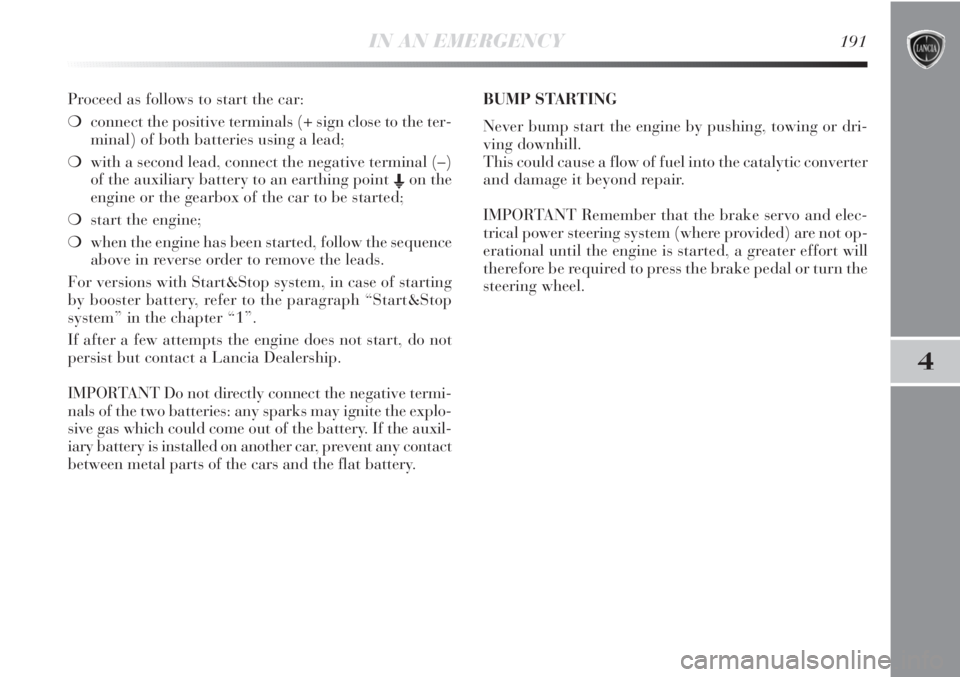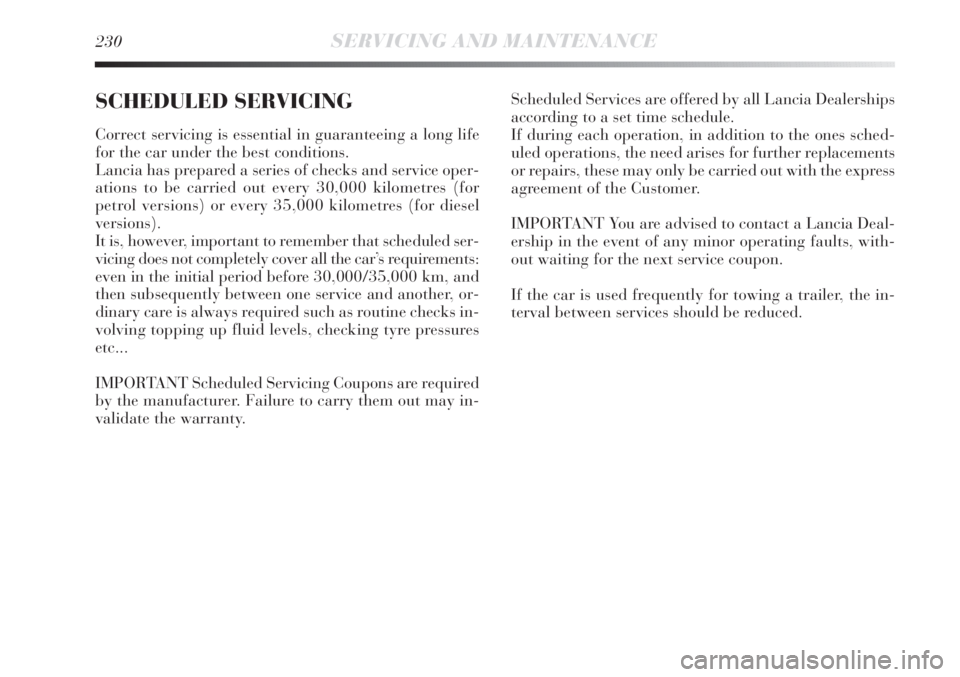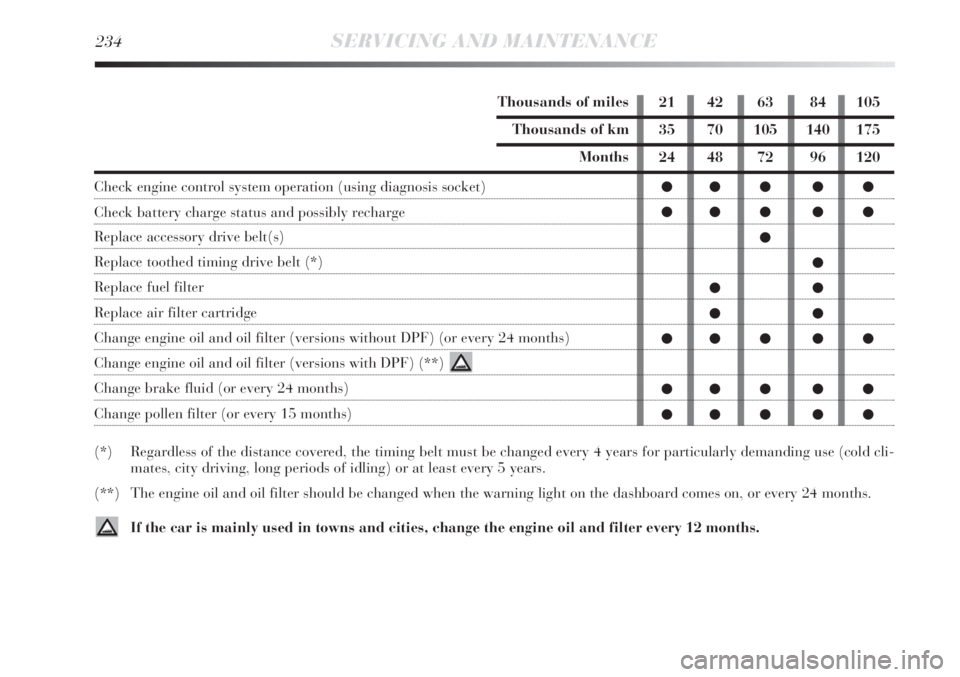tow Lancia Delta 2012 Owner handbook (in English)
[x] Cancel search | Manufacturer: LANCIA, Model Year: 2012, Model line: Delta, Model: Lancia Delta 2012Pages: 295, PDF Size: 8.29 MB
Page 191 of 295

4
IN AN EMERGENCY189
Engine starting ....................................................................... 190
Quick tyre repair kit Fix&Go Automatic ................................. 192
Replacing a wheel ................................................................... 199
Changing a bulb ..................................................................... 206
Replacing exterior bulbs .......................................................... 210
Replacing an interior bulb ....................................................... 215
Replacing fuses ....................................................................... 219
Battery recharging .................................................................. 226
Jacking the car ........................................................................ 227
Towing the car ........................................................................ 227
In an emergency we recommend that you call the freephone number
found in the Warranty Booklet.
It is also possible to go to the www.lancia.com website
to find the closest Lancia Dealership.
Page 193 of 295

IN AN EMERGENCY191
4
Proceed as follows to start the car:
❍connect the positive terminals (+ sign close to the ter-
minal) of both batteries using a lead;
❍with a second lead, connect the negative terminal (–)
of the auxiliary battery to an earthing point E
on the
engine or the gearbox of the car to be started;
❍start the engine;
❍when the engine has been started, follow the sequence
above in reverse order to remove the leads.
For versions with Start&Stop system, in case of starting
by booster battery, refer to the paragraph “Start&Stop
system” in the chapter “1”.
If after a few attempts the engine does not start, do not
persist but contact a Lancia Dealership.
IMPORTANT Do not directly connect the negative termi-
nals of the two batteries: any sparks may ignite the explo-
sive gas which could come out of the battery. If the auxil-
iary battery is installed on another car, prevent any contact
between metal parts of the cars and the flat battery.BUMP STARTING
Never bump start the engine by pushing, towing or dri-
ving downhill.
This could cause a flow of fuel into the catalytic converter
and damage it beyond repair.
IMPORTANT Remember that the brake servo and elec-
trical power steering system (where provided) are not op-
erational until the engine is started, a greater effort will
therefore be required to press the brake pedal or turn the
steering wheel.
Page 194 of 295

192IN AN EMERGENCY
❍informative leaflet (see fig. 3), used to ensure the cor-
rect use of the quick tyre repair kit and then given to
the personnel who will handle the treated tyre;
❍a compressor D-fig. 2 including a pressure gauge and
connections, found in the compartment;
❍a pair of protective gloves located in the side com-
partment of the compressor;
❍adapters for inflating different elements.
The quick repair kit also contains a screwdriver and a tow
ring.
fig. 3L0E0076m
QUICK TYRE REPAIR KIT
FIX & GO AUTOMATIC
The quick tyre repair kit Fix & Go automatic is located
in the luggage compartment.
The kit fig. 2 includes:
❍a canister A containing sealant liquid and fitted with:
– filler tube B;
–
an adhesive label C with the message “max. 80 km/h”
to be applied in a position clearly visible by the dri-
ver (on the dashboard) after repairing the tyre;
fig. 2L0E0075m
Page 202 of 295

200IN AN EMERGENCY
The driving characteristics of the car may
change when a space-saver wheel is fitted.
Avoid sudden acceleration and braking, sud-
den steering and fast cornering. The total life of
a space-saver wheel is approximately 3000 km,
after which it must be replaced by another wheel of
the same type. Never attempt to fit a conventional
tyre on a rim designed for use as a space-saver
wheel. Have the punctured wheel repaired and re-
placed as soon as possible. Two or more space-
saver wheels should never be used together. Do not
apply grease to the bolt threads before assembly:
they might spontaneously unscrew.The jack can only be used for changing
wheels on the car with which it is provided or
on cars of the same model Never use the jack
for other purposes, such as lifting other car models.
In no case should it be used for repairs under the
car. Incorrect positioning of the jack may cause the
jacked car to fall. Do not use the jack for loads
higher than those shown on the label. Snow chains
cannot be fitted to the space-saver wheel. So, if
a front (drive) wheel is punctured and chains are
needed, a rear wheel should be fitted to the front of
the car and the space-saver wheel should be fitted
to the rear. This way, with two normal front driving
wheels, you can install the snow chains on them,
thus resolving the emergency.
If the hub cap is not installed properly, it
may detach when the vehicle is running.
Never tamper with the inflation valve. Never
introduce tools of any kind between rim and tyre.
Regularly check tyre and space-saver wheel pres-
sure, complying with the data in the chapter “6”.
Tool box (versions with Bose HI-FI)
There is a tool box located in the luggage compartment
for versions with Bose HI-FI.
This box contains:
❍screwdriver;
❍tow hook;
❍wheel bolt spanner;
❍wheel bolt access spanner;
❍alloy wheel centring device;
❍jack.
Page 208 of 295

206IN AN EMERGENCY
After tyre replacement
❍Stow the space saver wheel D-fig. 10 in the space pro-
vided in the luggage compartment;
❍fit the partially open jack in its box forcing it lightly
to prevent it from vibrating when travelling;
❍put the tools back into place in the container;
❍stow the container, complete with tools, in the spare
wheel and tighten the locking device B-fig. 10;
❍reposition the boot mat correctly.
IMPORTANT Do not use inner tubes with tubeless tyres.
Check the inflation pressure of the tyres and the space-
saving wheel periodically.CHANGING A BULB
GENERAL INSTRUCTIONS
❍Before changing a bulb, check the contacts for rust-
ing;
❍burnt-out bulbs must be replaced by others of the
same type and wattage;
❍always check the alignment of the beam after chang-
ing a headlight bulb;
❍when a light is not working, check that the corre-
sponding fuse is intact before changing a bulb. For the
location of fuses, refer to the paragraph “Replacing
fuses” in this chapter.
Modifications or repairs to the electric sys-
tem that are not carried out properly or do
not take the system technical specifications
into account can cause malfunctions leading to the
risk of fire.
Various fastening bolts and space-saver
wheels, specific and differing in structural
characteristics, are used depending on the
wheel rim type (alloy or steel). Fastening bolts for
alloy rims can be identified by the presence of a per-
manent washer and a hollow side on the bolt head.
Therefore, you will need to go to a Lancia Dealer-
ship to get the correct type of fastening bolts and
space saver wheel if you change the type of wheels
fitted (alloy rims instead of steel rims, or vice
versa). Keep the bolts fitted as standard in case of
re-use of the wheels originally mounted on the car.
Page 209 of 295

IN AN EMERGENCY207
4
Halogen bulbs contain gas under pressure;
if they break, glass fragments may be dis-
persed.IMPORTANT The headlight inner surface might be
slightly misted: this should not be considered irregular
rather a natural phenomenon due to low temperature and
the air humidity level. Misting will disappear as soon as
the headlights are turned on. The presence of drops in-
side the headlights indicates infiltration of water. Contact
a Lancia Dealership.
IMPORTANT When the weather is cold or damp or after
heavy rain or after washing, the surface of headlights or
rear lights, may steam up and/or form drops of conden-
sation on the inside. This is a natural phenomenon due
to the difference in temperature and humidity between the
inside and the outside of the glass which does not indicate
a fault and does not compromise the normal operation of
lighting devices. The mist disappears quickly when the
lights are turned on, starting from the centre of the dif-
fuser, extending progressively towards the edges.
When handling halogen bulbs, only touch the
metal part. If the transparent bulb is touched
with the fingers, its lighting intensity is re-
duced and life of the bulb may be compromised. In
the event of accidental contact, wipe the bulb with
a cloth moistened with alcohol and leave it to dry.
Where possible, it is advisable to have bulbs
changed at a Lancia Dealership. Proper op-
eration and orientation of the external lights
are essential for driving safety and complying
with the law.
Page 229 of 295

IN AN EMERGENCY227
4
Battery fluid is poisonous and corrosive:
avoid contact with your skin and eyes. The
battery recharging operation must be per-
formed in a ventilated place, away from naked
flames or possible sources of sparks to avoid the
risk of explosion and fire.
Don’t try to recharge a frozen battery: If the
battery was frozen, have it inspected by
skilled personnel before recharging to check
that the internal elements are not damaged and that
the casing is not cracked, which causes the risk of
leakage of poisonous, corrosive acid.
JACKING THE CAR
If the car is to be lifted, go to a Lancia Dealership which
is equipped with the arm hoist or workshop lift.
TOWING THE CAR
The tow ring, which is provided with the car, is housed
in the tool box, under the boot mat.
FASTENING THE TOW RING fig. 44-45
Proceed as follows:
❍release cap A;
❍take the tow ring B from its housing in the tool sup-
port;
❍screw the ring onto the rear or front threaded pin.
fig. 44L0E0297m
❍connect the positive cable to the positive battery ter-
minal E and the negative terminal to the sensor D as
shown in the figure;
❍turn on the charger. Turn the device off after recharg-
ing;
❍after having disconnected the recharging device, re-
connect the connector A to the sensor C as shown in
the figure.
Page 230 of 295

228IN AN EMERGENCY
When towing, remember that without the
help of the brake servo and electric power
steering, a greater effort is required on the
pedal and steering wheel. Do not use flexible ca-
bles when towing and avoid jerky movements.
While towing, make sure not to damage parts in
contact with the car. When towing the vehicle, it is
compulsory to respect specific highway code reg-
ulations relating to the tow hook and procedures for
towing on the road. Do not start the engine while
towing the car. Before tightening the ring clean the
threaded housing thoroughly. Make sure that the
ring is securely fastened before towing the car.
The front and rear tow hooks must only be
used for emergency situations on the road.
The car may be towed for short distances
when a dedicated device is used in compliance with
the Highway Code (rigid bar), and in order to move
the vehicle on the road in preparation for towing by
a tow truck. Tow hooks MUST NOT be used to tow
vehicles off the road or where there are obstacles
and/or for towing operations using cables or other
non-rigid devices. Respecting the above conditions,
towing must take place with two vehicles (one tow-
ing, the other towed) aligned as much as possible
along the same centre line.
fig. 45L0E0091m
Before towing, turn the ignition key to MAR
and then to STOP without removing it. The
steering column will automatically lock
when the key is removed and the wheels cannot be
steered.
Page 232 of 295

230SERVICING AND MAINTENANCE
SCHEDULED SERVICING
Correct servicing is essential in guaranteeing a long life
for the car under the best conditions.
Lancia has prepared a series of checks and service oper-
ations to be carried out every 30,000 kilometres (for
petrol versions) or every 35,000 kilometres (for diesel
versions).
It is, however, important to remember that scheduled ser-
vicing does not completely cover all the car’s requirements:
even in the initial period before 30,000/35,000 km, and
then subsequently between one service and another, or-
dinary care is always required such as routine checks in-
volving topping up fluid levels, checking tyre pressures
etc...
IMPORTANT Scheduled Servicing Coupons are required
by the manufacturer. Failure to carry them out may in-
validate the warranty.Scheduled Services are offered by all Lancia Dealerships
according to a set time schedule.
If during each operation, in addition to the ones sched-
uled operations, the need arises for further replacements
or repairs, these may only be carried out with the express
agreement of the Customer.
IMPORTANT You are advised to contact a Lancia Deal-
ership in the event of any minor operating faults, with-
out waiting for the next service coupon.
If the car is used frequently for towing a trailer, the in-
terval between services should be reduced.
Page 236 of 295

234SERVICING AND MAINTENANCE
Thousands of miles
Thousands of km
Months
Check engine control system operation (using diagnosis socket)
Check battery charge status and possibly recharge
Replace accessory drive belt(s)
Replace toothed timing drive belt (*)
Replace fuel filter
Replace air filter cartridge
Change engine oil and oil filter (versions without DPF) (or every 24 months)
Change engine oil and oil filter (versions with DPF) (**)
Change brake fluid (or every 24 months)
Change pollen filter (or every 15 months)
(*) Regardless of the distance covered, the timing belt must be changed every 4 years for particularly demanding use (cold cli-
mates, city driving, long periods of idling) or at least every 5 years.
(**) The engine oil and oil filter should be changed when the warning light on the dashboard comes on, or every 24 months.
If the car is mainly used in towns and cities, change the engine oil and filter every 12 months.
21 42 63 84 105
35 70 105 140 175
24 48 72 96 120
●● ● ● ●
●● ● ● ●
●
●
●●
●●
●● ● ● ●
●● ● ● ●
●● ● ● ●